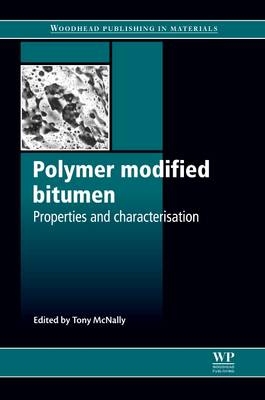
Polymer Modified Bitumen
Woodhead Publishing Ltd (Verlag)
978-0-85709-048-5 (ISBN)
- Keine Verlagsinformationen verfügbar
- Artikel merken
The addition of polymers to bitumen allows the modification of certain physical properties, such as softening point, brittleness and ductility, of the bitumen. Polymer modified bitumen: Properties and characterisation provides a valuable and in-depth coverage of the science and technology of polymer modified bitumen.
After an initial introduction to bitumen and polymer modified bitumen, the book is divided into two parts. Chapters in part one focus on the preparation and properties of a range of polymer modified bitumen, including polymer bitumen emulsions, modification of bitumen with poly (urethanes), waste rubber and plastic and polypropylene fibres. Part two addresses the characterisation and properties of polymer modified bitumen. Chapter topics covered include rheology, simulated and actual long term ageing studies; the solubility of bituminous binders in fuels and the use of Fourier transform infrared spectroscopy to study ageing/oxidation of polymer modified bitumen.
Polymer modified bitumen is an essential reference for scientists and engineers, from both academia and the civil engineering and transport industries, interested in the properties and characterisation of polymer modified bitumen.
Tony McNally is a Faculty Member in the School of Mechanical and Aerospace Engineering at Queen’s University Belfast, UK. He is a Fellow of the Royal Society of Chemistry (FRSC).
Contributor contact details
Part I: Types of polymer modified bitumen
Chapter 1: Introduction to polymer modified bitumen (PmB)
Abstract:
1.1 Bitumen
1.2 Polymer modified bitumen
1.3 Introduction to Polymer modified bitumen: properties and characterisation
Chapter 2: Polymer modified bitumen emulsions (PMBEs)
Abstract:
2.1 Introduction
2.2 Manufacturing polymer modified bitumen emulsions (PMBEs)
2.3 Uses of PMBE
2.4 Conclusions
Chapter 3: Modification of bitumen using polyurethanes
Abstract:
3.1 Introduction
3.2 Bitumen modification by polymers
3.3 Modification by isocyanate-based reactive polymers
3.4 The role of the bitumen colloidal nature
3.5 Polyurethane/urea-based modified bitumen
3.6 Bitumen foaming and future trends
3.7 Sources of further information and advice
Chapter 4: Rubber modified bitumen
Abstract:
4.1 Introduction
4.2 Waste rubber recycling
4.3 Shredding of scrap rubber from tyres
4.4 Methods of bitumen modification with crumb rubber
4.5 Rubber-bitumen interactions
4.6 Properties of rubber modified bitumen
4.7 Properties of asphalt–rubber mixture
4.8 Performance of pavement with asphalt–rubber mixture
4.9 Economic benefits
4.10 Conclusions
Chapter 5: The use of waste polymers to modify bitumen
Abstract:
5.1 Introduction
5.2 Processing of waste polymer modified bitumens
5.3 Thermomechanical properties of waste polymer modified bitumens
5.4 Future trends
5.5 Sources of further information and advice
Chapter 6: Polypropylene fiber-reinforced bitumen
Abstract:
6.1 Introduction to polypropylene modification of asphalt concrete
6.2 Using polypropylene fibers to improve the fatigue life of asphalt concrete
6.3 Experiments used to enhance the physical and mechanical properties of polypropylene fiber-reinforced asphalt mixtures
6.4 Analysing the fatigue life of bituminous concrete
6.5 Analysing the repeated creep behaviour of bituminous concrete by utilising wet basis modification
6.6 Using artificial neural networks to predict physical and mechanical properties of polypropylene-modified dense bituminous mixtures
6.7 Determining the optimal polypropylene fiber modification of asphalt concrete utilising static creep tests, Marshall tests and fluorescence microscopy analyses
6.8 Conclusions
Part II: Characterisation and properties
Chapter 7: Rheology of polymer-modified bitumens
Abstract:
7.1 Introduction
7.2 Rheological characterisation of polymer-modified bitumen at in-service temperatures
7.3 Case studies
7.4 Conclusions and future trends
7.5 Sources of further information and advice
Chapter 8: Factors affecting the rheology of polymer modified bitumen (PMB)
Abstract:
8.1 Introduction
8.2 Polymer modification
8.3 Conventional physical property tests
8.4 Advanced rheological characterisation
8.5 Ageing
8.6 Asphalt mixture performance
8.7 Conclusions
Chapter 9: Ageing of polymer modified bitumen (PMB)
Abstract:
9.1 Introduction
9.2 Main causes of ageing for polymer modified bitumens (PMBs)
9.3 Simulative ageing methods of polymer modified bitumens (PMBs)
9.4 Ageing performance and characterization of polymer modified bitumens (PMBs)
9.5 Methods for improving the ageing resistance of polymer modified bitumens (PMBs)
9.6 Future trends in research on polymer modified bitumen (PMB) ageing
Chapter 10: Natural weathering of styrene–butadiene modified bitumen
Abstract:
10.1 Introduction
10.2 Background
10.3 Bituminous sealants and methods of analysis
10.4 Weathering of bituminous sealants
10.5 Future trends
Chapter 11: Fuel resistance of bituminous binders
Abstract:
11.1 Introduction
11.2 Solubility of bituminous binders
11.3 Bitumen modification to enhance fuel resistance
11.4 Conclusions
Chapter 12: Physico-chemical techniques for analysing the ageing of polymer modified bitumen
Abstract:
12.1 Introduction
12.2 Usual methods for physico-chemical characterization of polymer modified bitumen (PmB) ageing
12.3 Investigation at the microscopic scale of polymer modified bitumen (PmB) ageing
12.4 Conclusions
12.5 12.5 Acknowledgements
Index
| Erscheint lt. Verlag | 15.9.2011 |
|---|---|
| Reihe/Serie | Woodhead Publishing Series in Civil and Structural Engineering |
| Verlagsort | Cambridge |
| Sprache | englisch |
| Maße | 156 x 234 mm |
| Gewicht | 760 g |
| Themenwelt | Technik ► Elektrotechnik / Energietechnik |
| ISBN-10 | 0-85709-048-8 / 0857090488 |
| ISBN-13 | 978-0-85709-048-5 / 9780857090485 |
| Zustand | Neuware |
| Haben Sie eine Frage zum Produkt? |
aus dem Bereich


